 Faction Style Guide
Faction Style Guide
This guide is to help content creators craft their items to fit within Warframe's ever-evolving universe. We love new ideas, but we need our world to be cohesive so that we can develop story, explore the solar system and restore balance as high-tech warrior ninjas.
Warframe is a visually diverse game with factions ranging from the flowing silhouettes and sweeping curves of the Tenno, to bulbous and industrial Grineer, to hard edged and geometric Corpus, to horrifying Infested and beyond. We keep these distinct forces unified in a sci-fi universe that, while space faring, is gritty, lo-fi and full of character. Our gameplay is fast paced, energetic and intense. We compliment that with art that is ‘over-the-top’ in design and a focus on the whole, not details.
At this moment, we are accepting items within the following Factions:
- Tenno
- Grineer (including subfactions, like Kuva)
- Corpus (including subfactions, like Terra)
- Infested
- Sentient
- Solaris (including subfactions, like Vent Kids)
- Ostron (including subfactions, like Quills)
- Entrati
General notes:
- We aim for moderate stylization, with twists on conventional pop formulas: Our space marines are villains suffering from generation loss, the business suits of our merchant class are very unconventional, and you cannot help but feel sympathy for our monsters.
- Our art is realistic, but not overwhelmed with high-frequency detail. We try not to obsess over skin pores and when we do it often takes away from the aesthetic.
- We want a sense of immediacy and spontaneity. When we can get the energy of one of Mynki’s sketches directly into the game things are going well.
- Customization is very important to our community and a cosmetic item's potential is stunted if the piece does not support the amount and quality of customization that our community wants. This is easy to critique at the texturing phase, but it is wise to keep in mind from the earliest concepts for your piece.
- Items meant to work with a specific character (IE: A Mag alt helm) should reflect the character and what has come before.
We have developed several conventions for shape language and materials that will help you have your pieces fit in the world (IE: Grineer materials tend to be thick painted metal with a fair bit of grime and rust, Tenno materials are clean techno organic, but do include wear and very small amounts of rust).
Tenno:
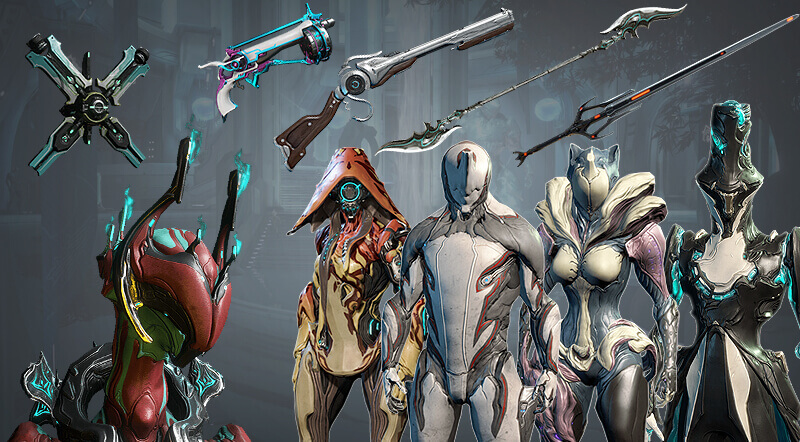
We are a mix of high tech warrior and ninja. We wear the distinct techno-organic Warframes dating back to the old war and beyond. With our Warframes we command unearthly power and our skill with gun and blade is legendary.
- Metal parts are generally fairly sparse with this faction, acting as pins and brackets and sometimes flowing borders on forms. A layered feel is important, as well as some tooling details and some dirt/grime in the valleys. Should feel sleek but functional.
- Fabric for the Tenno tends to be organic in nature, as if it was “grown”, rather than relying on actual woven fabric texture IE Limbo and Mesa. Look at Octavia for an example of patterned “fabric”. Avoid modern-looking weaves or stitching.
- Sleek and elegant, with a flowing silhouette! Think curves, and long straight lines.
- Avoid repetition of shapes, like scales.
- Technology and organic forms mixed. Tech areas are very dense with lots of layered detail, usually occupying inner areas or poking out of joints or areas of interest. Organic forms are long and sweeping with subtle creases on larger surfaces, and often act as a covering over tech.
Grineer:
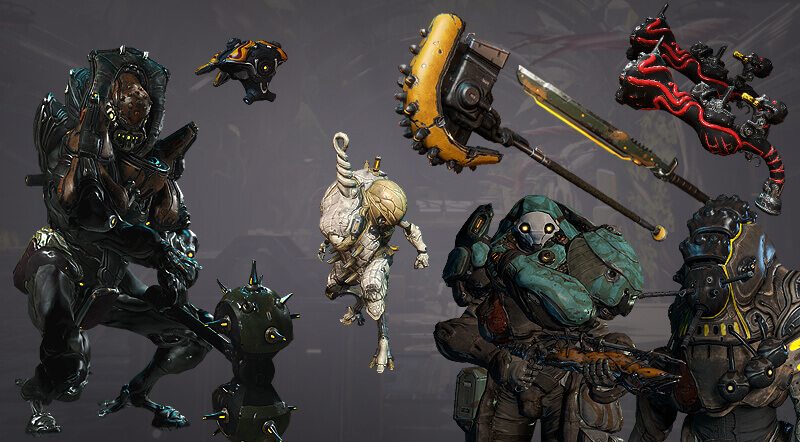
The Grineer are far from your average high tech sc-ifi style, owing to their reliance on brute force and access to only crude materials. Avoid making beautiful, flowing lines for this faction to help separate them from Tenno.
- Metals are rough, chunky, and grimy. These are areas of high detail, but are not too sleek or high-tech.
- Fabrics are thick military-style, wrinkled and stretched over tech. Grungy, sometimes tattered, and definitely not elegant.
- Chipped paint and industrial detailing in key areas. Look to add wear and tear in key areas that tells a story of how it’s used and worn.
- Bulky uneven silhouettes are key. Grineer are bulbous with crudely constructed armour / weaponry.
Corpus:
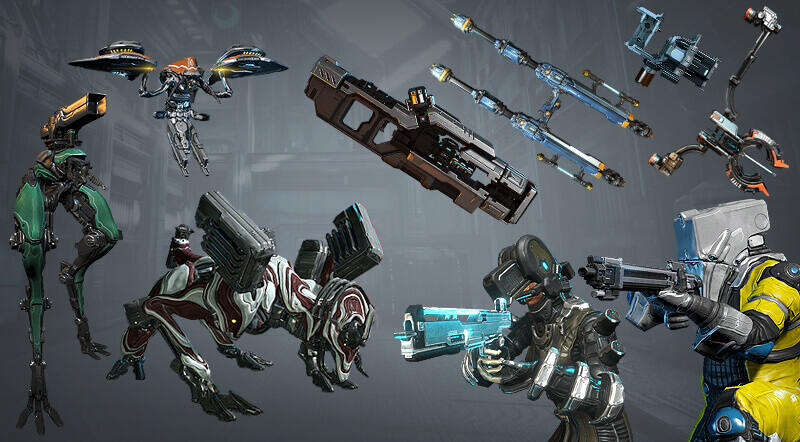
The Corpus are a race of merchant traders, and have access to science labs to develop their technologies, so their construction style is much more refined and advanced than the Grineer but more industrial and boxy than the Tenno. As they are a merchant race, avoid making anything look too purposely military.
- Boxy, beveled, clunky forms broken up by areas of intricate technical detail. Bracket-like details used to break up the silhouette.
- Animal-style Corpus is based on Warframe tech, with smooth rubbery forms stretched over the usual technical parts i.e. Zanuka, Orb Mothers, Shield Osprey.
- Metals are layered. Corpus have high metallic and shininess values, with greater surface area occupied by metallics vs other factions.
- Weaponry use geometric volumes and focus on function over form. Ergonomics don’t matter for the user, so long as the technology can perform its purpose.
Infested:
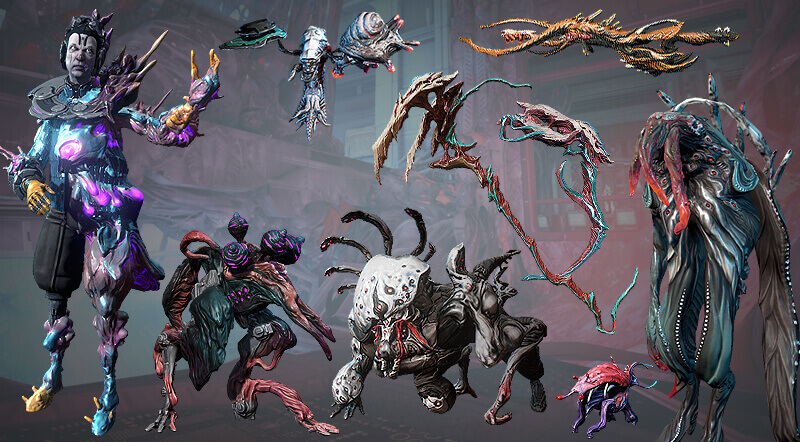
The infestation itself is a disease that transforms other materials into flesh, and grows in unexpected, horrifying ways. This faction’s shape language is unbalanced, twisted, unsettling. Make sure to use lots of references with this faction as it is deceptively difficult to master, despite its chaotic, almost random-looking appearance.
- This faction is made up of muscle-like flesh, interlocking and stretching like sinews, with rubbery skin and glowing pustules.
- In lieu of metals, bladed parts and protective coverings are made of hardened bone. Each material has high contrast from each other in both shape and surface texture.
- As it is a disease, it is capable of “infesting” another faction. The “host” faction should remain distinct in pieces where this is happening -- you can tell where one ends and the other begins. Look at the Chargers (infested Grineer) and Tar Mutalists (infested Moas) as examples.
Sentient:
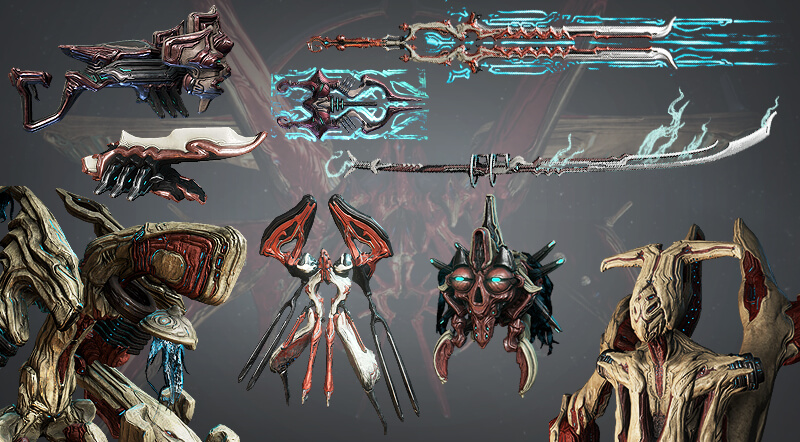
Highly adaptable and mysterious, Sentients can take various forms throughout the Sol System: as combat drones, Eidolons on Earth, or Amalgams on Jupiter. We are avoiding spoilers in this guide, but more about this faction is revealed as you progress through the main Quests.
This is one of the most nuanced Factions in-game, so we have quite an extensive guide prepared for you below.
Each tint has its own material usage and this should be respected on all Sentient Creations. How you balance these four materials is up to you, but these four materials need to be present:
- One tint is bone-like, fewer details, flatter with some flared shapes here and there.
- Another is semi-metallic, with geometric tube-like forms. This material should be manufactured-feeling but still organic in terms of surface treatment, with imperfections like dimples and pockmarks here and there, and a slight wobble to the lines.
- The third is like rubber. This material should be more technical, and set beneath the other layers so it's set into the main shapes a bit. Tighter details are good here, with technical forms used as accents.
- The final tint is full metallic. This should be used sparsely for more bracket-like details and some actual mechanical features. This metal is used to punctuate the artifice of the faction.
Solaris:
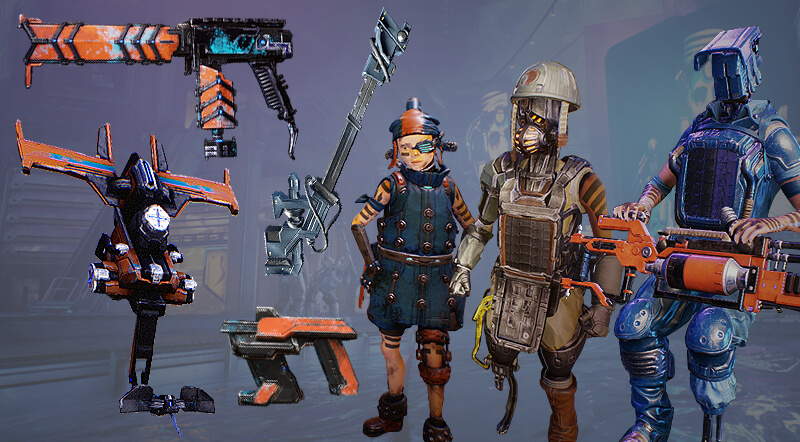
The Solarians are members of the debt-internment colony of Fortuna, crushed under Nef Anyo’s heel. Piece by piece, parts of their bodies are exchanged for cybernetic enhancements to increase productivity, resulting in an aesthetic that is a mix of robotics and flesh. This faction also takes influence from 1980s B sci-fi movies, especially their practice of kitbashing (which you can see in Kitguns), so feel free to use those for inspiration!
- The Solaris garb is a mix of utilitarian cloth and bulky geometric metal pieces, connected with tubes and straps. Unlike the Corpus, whose shapes are more polished and sophisticated, the Solaris use blunted metal forms added to their human-like silhouettes.
- Solaris use large sections of metal, which is heavily worn, with chipped paint or a dull rough surface. The metal can be smooth, but pockmarked and/or hammered texturing is also common. Smaller shiny metal details like brackets or rivets can also be used as accents on both metal and non-metal materials.
- This faction uses a mix of flesh, utilitarian cloth like canvas and rubber, and metal. The cloth is often bulky, sometimes with vertical quilts, and is used mostly for warmth and protection. This cloth can have a subtle woven texture, or a slightly shiny surface (like rubber) and is usually placed below the metal outer layer, and placed on top of flesh (where applicable). Tubing is also used to connect between metal sections, made out of rubber or shiny plastic.
- The silhouette is dominated by bulky painted metal pieces, on top of thick fabrics. The uniquely shaped heads and metal grates on the chest are a key feature of this faction.
- Solaris are rough and grimy from long days of hard work. Oil stains, chipped metal and worn cloth are commonplace. Cloth or brackets can be used as wrapping to repair broken items, or hold the mish-mash of metal pieces onto their bodies. Solid rectangular line tattoos are also common, and are fun to include if you wish.
IMPORTANT NOTE: Literal clothing and hoods on Warframes is best avoided. Focus on abstraction, look at Mesa and Hydroid Prime for examples of how to approach this. Solaris has a lot of unique detail and surface treatment that can be used without making literal Solaris suits for your Warframes!
Ostron:
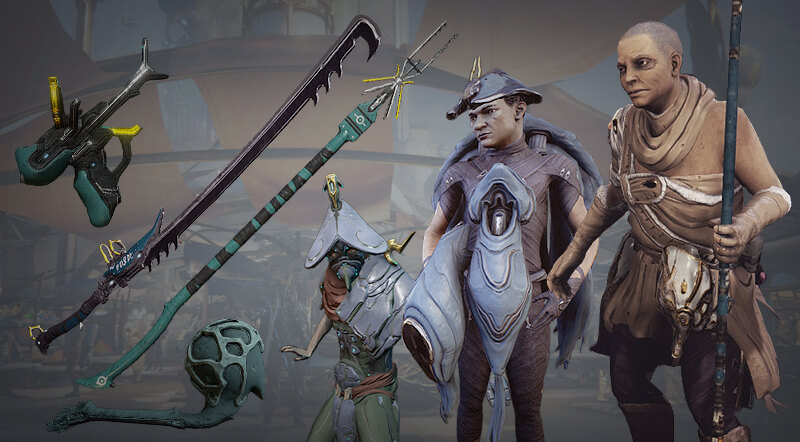
The Ostrons are rough and utilitarian, harvesting their livelihood from the Orokin Tower that looms over Cetus. Their garb is crudely-hewn and bulky, made mostly of layers of fabric and repurposed materials, with small golden Orokin accents. The Quills are a sub-faction with a focus on combat, meaning their clothing serves more as armor, with additional plating not seen on the Cetus residents.
- Metal is very aged but uses Orokin and Tenno-like sculpting, and only used sparingly as pins and brackets or as adornment. On weapons or armor, the metal is often simply constructed, featuring some curves and serrated edges.
- This faction uses mostly cloth-like materials to construct their garments. These can sometimes have a subtle textile pattern on them, but usually it is slightly shiny and smooth, like leather. This cloth is strapped and draped and wrapped around the body, resulting in many layers. On top of this, you can find reclaimed materials used as adornment or for practicality, featuring ceramic-like materials, or some armor plating, or even wrapped wood.
- The silhouette is bulky and often asymmetrical, with many materials layered on top of each other. You can easily see how each garment is constructed via pieces of cloth strapped around the body, so long draping pieces of cloth are common.
- Because the Ostron rely on reclaimed materials, or goods they can harvest themselves, their materials are often well-worn, tattered, and sometimes a little grimy.
- The Ostron have their own text that can be used as scrolls or emblems on your designs. You can download it for yourself from our Fansite Kit.
IMPORTANT NOTE: Literal clothing and hoods on Warframes is best avoided. Focus on abstraction, look at Mesa and Hydroid Prime for examples of how to approach this. Ostron has a lot of unique detail and surface treatment that can be used without making literal Ostron suits for your Warframes!
Entrati:
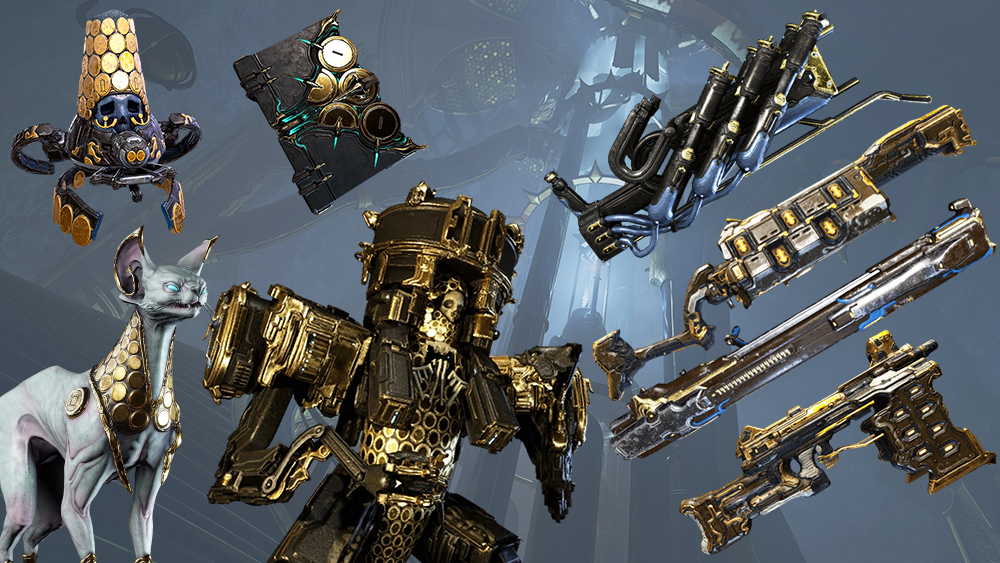
During the Orokin era, the Entrati were highly renowned for their scientific achievements, especially their breakthroughs in Void travel. They conducted research on Deimos, the now-Infested moon of Mars. The Entrati faction often resembles the Orokin faction, but they differentiate themselves visually with low-tech solutions that are boxy, weathered and beaten up.
- Entrati works are not pristine, perfectly preserved artifacts. Their surfaces have endured centuries of abuse on Deimos, and thus they are scratched and well-worn.
- Silhouette shapes tend to be simple, with primarily heavy and boxy forms.
- Although present on some of our in-game Entrati items, do not use skulls on your Entrati TennoGen creations.
- The round Entrati Obols (coin-like objects) present on many Entrati items are a distinguishing feature of this faction.
- Favor arranging these in groups that create regular patterns with ‘coins’ all being the same size.
- Avoid making them too small or like scales: we want them to be readable as separate discs from a distance. Good references for this usage include the Voidrig Necramech, and Necraloid.
- Like with other Factions, we have a recommended Material breakdown per tint to best capture the Entrati style:
- Materials on Tint 1: Simple ‘shell’ surfaces with noticeable thickness and scratched up edges/surfaces. (This is a common material treatment seen throughout Warframe)
- Materials on Tint 2: Tenno-style rubbery ‘tech’ surfaces, but blockier than what is seen for Tenno. This material should have a lot more greeble compared to the shell (Tint 1).
- Materials on Tint 3: Either a painted motif on the first material, or a separate, shinier “plastic” kind of material around the technical areas. The light blue tints on Morgha and Mausolon are good examples of this plasticky treatment.
- Materials on Tint 4: Chunky gold embellishments are added on top of the other Materials, with bold, blocky forms. Artists can also use this Tint to incorporate the round ‘coin’ (Entrati Obol) design if they wish.
- Painted motifs (if present) are often floral inspired, with thick linework. Voidrig Necramech and Bonewidow Necramech both are good references for these motifs.
- Gold is permitted for Entrati faction TennoGen items, but the material must be worn and dirty to reflect the passing of time. Unlike Prime/Orokin designs, these gold metal details are chunky and utilitarian looking. Avoid sleek golden embellishments for Entrati.